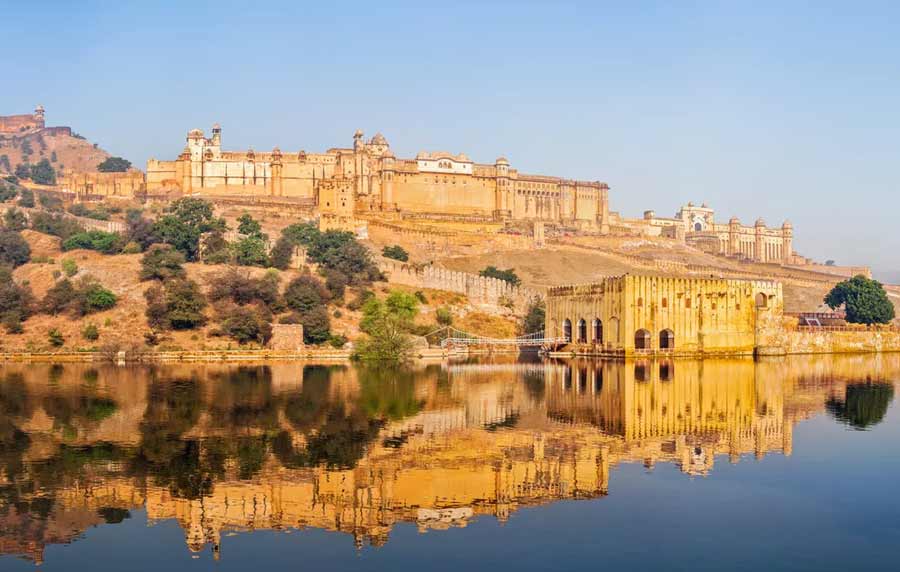Ranthambore Fort
This World Heritage Sites in Rajasthan is located near the town of Sawai Madhopur in Rajasthan. The Ranthambore Fort has been a witness to the glory of the Chauhan dynasty. The fort lies within the Ranthambore National Park, which used to serve as a hunting ground for the Maharajahs of Jaipur before Indian independence. Broadly, the Ranthambore fort, having an area of nearly 4 square Kms is virtually divided in two parts. The western part of the fort having many temples, Stambhas and other ancient monuments is generally full of visitors, whereas the eastern part of the fort is generally considered as a wild area where you can easily spot a number of birds, Langurs, the odd small cat, leopards and even the very rare and elusive Fishing cat.
The Ranthambhore fort is believed to have been built during the 8th century by the Chauhans ruler, though the exact ruler during whose reign the fort was initiated is difficult to name. Ranthambhore came into existence after Prithvi Raj Chouhan who was last Hindu king of Delhi,Prithvi Raj Chouhan's descendents came to Ranthambhore and made this place their capital, but the actual fame of Ranthambore came when most known ruler of this period Raja Hammir Dev was crowned in 1283 A.D.The fort was attacked by a number of big powers at different point of time in history.Prominent among these were Qutub-ud-din (1209), Allaudin Khilji (1301), Feroz Tughlaq (1325) and Bahadur Shah of Gujarat (1530).Finally, the fort was captured by the Mughals who earlier used it as a staying place and then later as a prison fortress.In the 19th century, the fort was given back to the Maharaja of Jaipur and it remained with them till the time India gained independence in the year 1947.
The Ranthambore Fort spreads over an area of 7 kilometers in circumference and includes an area of nearly 4 square kilometers. The fort had many buildings inside of which only a few have survived the ravages of wars and time. Among the remaining ruins, the two pavilions, Badal Mahal , Dullah Mahal, 32 Pillared Chhatri and Hammirs court give an idea of the old grandeur.The Fort also has many cenotaphs, mosques,temples, barracks, step-well and gates. All around the fort you can see many old ruins with remnant of walls are mute testimony of past.For water supply there are two rain fed reservoirs in the fort. The fort is surrounded by massive stonewalls which are strengthened by towers and bastions. The entire stone for masonry work has been mined from fort area itself and the mines were later turned into ponds for water storage.
The Ganesha Temple is major attraction of the fort, Thousands of people come here from every corner of the country,and seek blessings from the Lord for happiness and prosperity. A good day to visit the fort is Wednesday, the day of the Lord Ganesh, when a lot of local people visit the Ganesh temple.One interesting aspect is the mail that is sent to Lord Ganesha consisting mainly of wedding invitations. These letters are delivered daily by the local postman. The Fort is good place for bird watching. There are large numbers of birds, Langurs, the odd small cat and elusive Fishing cat use the area.
UNESCO World Heritage Sites Rajasthan
Rajasthan, in India literally draws its name from the fact that it was once home to the Kings of the country. The royal legacy that the country saw in the Rajput and Mughal eras, led to the development of number of World Heritage Sites in Rajasthan. The numbers of historical monuments of the Royal Rajput and Mughal era are still present in the city. These historical monuments speak of the splendor and the grandeur of the ancient times. The ambience and aura of these sites carry a touch of the Royalty of the Mughal and Rajput rules of the country, which is almost impossible to be repeated today. As a result, the unmatched beauty and grandeur of these sites have made UNESCO to declare and pamper some of them as World Heritage Sites in Rajasthan. Apart from its rich and colorful culture, Rajasthan draws tourists in humongous numbers with its majestic forts and wildlife areas. Some of these places are so significant that these have made it to UNESCO’s World Heritage Site list. The Hill Forts of Rajasthan comprises six magnificent fortresses that have stood the test of time, giving a peek into the state’s storied past and aesthetical evolution. Apart from these, a protected territory and an astronomical observatory are also UNESCO World Heritage Sites.
 +91 9799050299
+91 9799050299 









